|
Polyura nepenthes (Grose-Smith, 1883) - §Ñ¼~§Àß潺 - Shan Nawab
| Distribution | The Butterfly | Number of Broods | Courtship and Mating | Ovipositing behaviour | Food plant | Early stages | Acknowledgment | Reference | Plates |
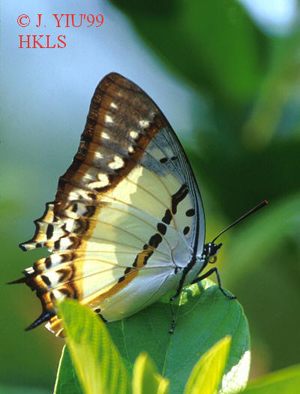 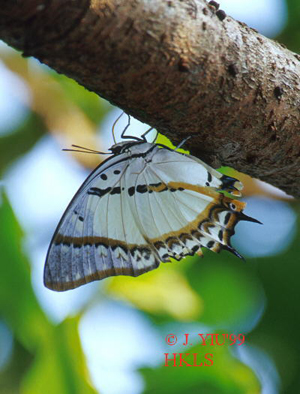
Reprint from FUTAO No.24, 1997
Entomological reports of FUTAO-KAI
C/O Hiroto HANAFUSA - 688-2, Tashima, Tottori-shi, Tottori, 680-0804 JAPAN / January 13, 1997
A brief note on the life history of Polyura nepenthes (GROSE-SMITH) in Hong Kong
James J. YOUNG - 20/F Tung Wai Comm. Bldg., 109-111 Gloucester Road, Wanchai, Hong Kong
Abstract
Polyura nepenthes is a new record for Hong Kong. The general characteristics of the butterfly are described and a summary of its life history is illustrated by colour photographs.
Key Words Nymphalidae, Polyura nepenthes, life history, Hong Kong.
Distribution
Since described by GROSE-SMITH in 1883, the detailed distribution is not clearly defined. However, this species is recorded to cover a vast area from Burma. Laos, N. Vietnam, Thailand and Central to Southern China. It is not found in Taiwan. Two subspecies are recognized.
The Butterfly
Polyura nepenthes can be said to be relatively large in size among other species of the same genus. It is a strong flyer with striking white creamy colour in flight suffused with black margins on the forewings. While the only other Polyura athamas that files in the same locality is a lot smaller with lesser black and dull greenish creamy colour in flight. Only two types of Polyuras so far are confirmed to be found in Hong Kong. The two sexes of Polyura nepenthes do not fly low apart from feeding and tend to settle again and again on the same point high up in the trees. They will always fold their wings when they are not in flight. The female is generally larger in comparison but resembles the other sex in appearance with the exception that the male has a totally white abdomen whereas the female is white and black beneath. Both sexes do not visit flowers and prefer rotten fruits, sap from trees in particular those of the citrus ones and animal dungs. They are found near streams and sometimes quite territorial. In fact, Polyura nepenthes appear to be a new comer to Hong Kong. They appear to have flown into Hong Kong from the Mainland China in the last couple of years and have bred locally throughout Hong Kong.
Number of Broods
The adults are generally on the wing from April to October. The butterflies have been seen in Kadoorie Farm, Tai Mo Shan Country Park, Tai Po Kau Nature Reserve, Wu Kau Tang, Sai Kung and even in Tung Chung - Lantau island in Hong Kong. In one particular instance, a female was observed in Wu Kau Tang, laying eggs on the food plant on which several eggs and larvae were found. Since then, the butterfly has been reared on various occasions to confirm its life history reported here. They appear to have at least 3 to 4 generations in a year and over winter in their final larval or pupal stage. Seasonal forms do not seem to exist though the spring ones appear to be a little bit smaller in comparison with the ones found during the summer months. This has to be confirmed by further rearing.
Courtship and Mating
No courtship and mating behaviour is observed but the male will generally chase the female around tree tops before mating. Hill-topping is common and one can find male Polyura nepenthes hill-topping in Koon Yam Shan in Kadoorie Farm, Tai Po and hills around Tai Mo Shan.
Ovipositing Behaviour
In one instance, a female was observed laying eggs at Wu Kau Tang, Tai Po around 12.30p.m. on 2nd June, 1996. It was indeed a very hot day and was about 32 degree centigrade. It flew down from tree tops and settled onto the food plant which is a climber. It touched the leaf with its abdomen and laid an egg on the upperside on the young leaf. All this happened in just a couple of seconds. It then flew off rapidly, returned again in about 30 to 60 seconds interval and laid another egg. It repeated itself for some 5 to 10 minutes and flew away and settled on top foliage of a nearby tree. Four to Five eggs were seen to have laid.
Food plant (Pl.3, figs.1,2) The climber is identified as Ventilago leiocarpa (BENTH) of the family Rhamnaceae found in Wu Kau Tang. Polyura nepenthes is also found feeding on Abarema lucida (BENTH) of Mimosaceae in Tai Po Kau Nature Reserve. Both food plants are common and this appears to be the reason why the species are so widespread in Hong Kong in recent years.
Early Stages (Pl.3, figs.3-21) Egg : It is typical of that of the Polyura as well as the Charaxes. It is glossy yellowish in colour when freshly laid, shaped like a barrel, flatten on top, ribbed and spherical curved towards the bottom, about 1.9mm in diameter and 2.1mm in height. It is laid flat, singly on top of young leaves.
Larva : After two or three days, the egg will turn brownish in colour and the caterpillar will emerge in about 5 days' time. The first instar is pale green in colour, brown forehead with 2 pairs of horns characteristised of that of the Polyura and Charaxes species. The emerging larva will consume the whole of its egg shell and the first instar lasts about 8 days. The larva is solitary and sits on the upperside of the young leaf with tiny silk pad spun upon the leaf. It tends to stay with the leaf and does not wander far to feed. It measures between 4mm to 5mm in length. The larva will consume its skin except its head capsule after each stage of changes. The larva usually rests with its head and thorax raised and stands on the prolegs only. When it is disturbed, the larva will often turn vigorously with its thorny head in an attempt to deter its passersby or predators as the case may be.
The 2nd instar takes about 9 to 10 days to complete and the larva will now turn greener in colour with brownish horns on its forehead. It now measures from 5mm to 1.3cm. The 3rd instar lasts about 12 to 14 days and now the caterpillar is totally green in colour with a bit of reddish colour on its horns. It measures up to 2.7cm. The 4th instar lasts about 10 to 11 days and the larva measures to 4.8cm. The 5th or final instar lasts from 16 to 27 days and grows to about 6cm in length until it is time for pupation.
Pupa : The larva will pupate on the leaf stalk attached by the cremaster at the end of the abdomen. The pupa is green in colour with some splashes of white on the surface. The shape of the pupa is typical of the Polyura and Charaxes species and is smooth in the form of a bugging banana. It measures from 2.2cm to 2.4cm. When it is time to emerge, the entire colour form of the butterfly wings will appear in the pupal case. It will then emerge within the next 24 hours usually in the early hours of the morning when there is light. It takes the butterfly about 15 to 17 days to emerge from the pupal stage. The whole duration from egg to adult takes approximately 84 days to complete.
Acknowledgments
I thank Dr. Alister BALLANTINE for his courtesy of lending me the prefect male specimen for photographing for this paper. Mr. George WALTHEW for accompanying me on various field trips and Mr. William Xing Fu-Wu of Kadoorie Farm for identifying the host plant-climber for me.
References
1) BASCOMBE, M.J. 1995 Checklist of the butterflies of South China - Memoirs of the Hong Kong Natural History Society.
2) CHOU, I. 1996 Monographia Rhopalocerorum Sinensium. Henan Scientific and Technological Publishing House.
3) CORBET, A. S. & PENDLEBURY, H.M. 1992 The Butterflies of the Malay peninsula. 4th edition revised by J.N.Eliot, Kuala Lumpur.
4) D'BRERA, B. 1985 Butterflies of the Oriental Region Part II. Hill House.
5) JOHNSTON, G. & B. 1980 This is Hong Kong: Butterflies. Government Printer.
6) MOTONO, A. & NEGISHI, N. 1989 Butterflies of Laos, Kirihara Shoten, Tokyo.
7) PINRATANA, A. & ELIOT, J.N. 1996 Butterflies in Thailand, Vol. Three-Nymphalidae.
Plates
Life history of Polyura nepenthes (GROSE-SMITH)
|
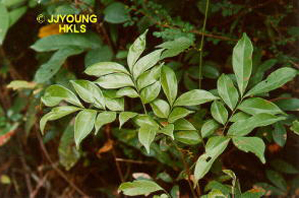
|
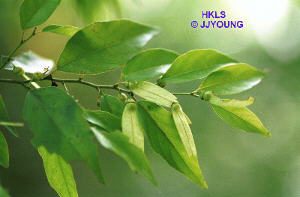
|
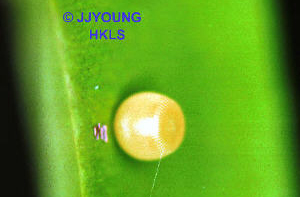
|
| 1) Host plant - leaves of Abarema lucida (BENTH) |
2) Host plant - Ventilago leiocarpa (BENTH) - leaves with seeds |
3) Eggs - freshly laid yellowish egg - side view |
|
|
|
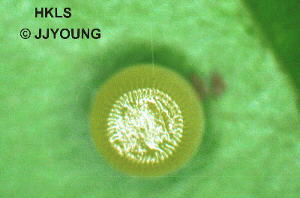 |
 |
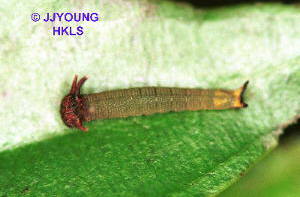 |
| 4) Freshly laid yellowish egg - top view |
5) Brownish egg with larva about to emerge |
6) 1st instar larva - front view |
|
|
|
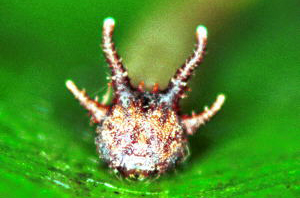 |
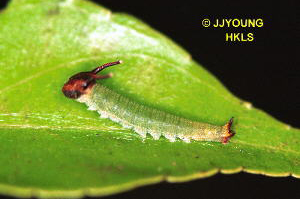 |
 |
| 7) 1st instar larva - forehead |
8) 2nd instar larva - side view |
9) 2nd instar larva - top view |
|
|
|
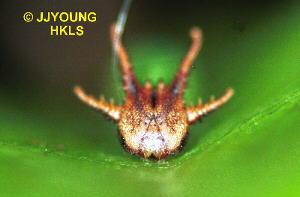 |
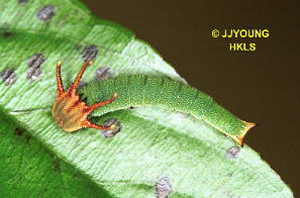 |
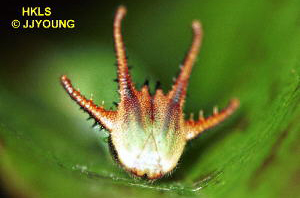 |
| 10) 2nd instar larva - forehead |
11) 3rd instar larva - top view |
12) 3rd instar larva - forehead |
|
|
|
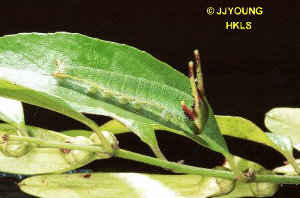 |
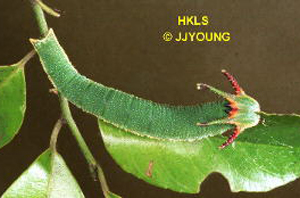 |
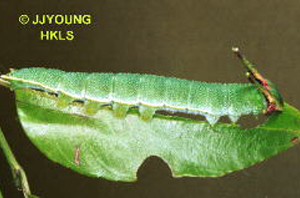 |
| 13) 3rd instar larva - side view |
14) 4th instar larva - top view |
15) 4th instar larva - side view |
|
|
|
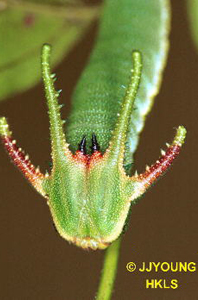 |
 |
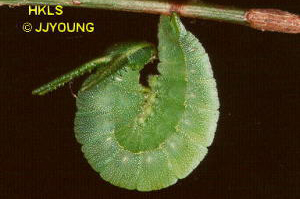 |
| 16) 4th instar larva - forehead |
17) 5th instar larva - top view |
18) larva - ready to pupate |
|
|
|
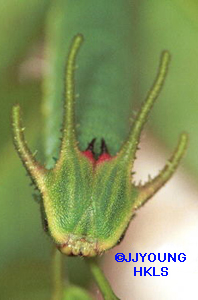 |
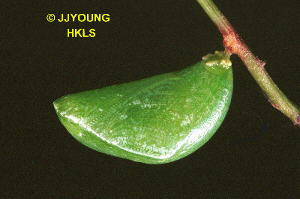
|
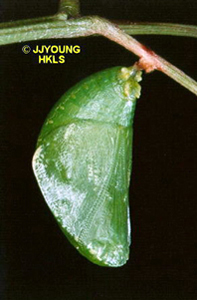
|
| 19) 5th instar larva - forehead |
20) Pupa - side view |
21) front view |
|
|
|
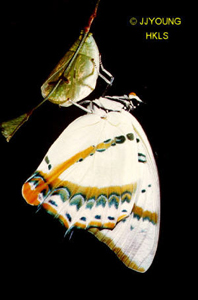
|
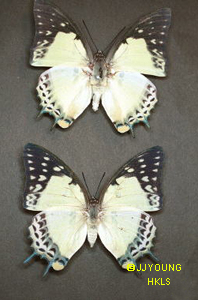
|

|
22) Emerging adult |
23) Adult male and female - upperside |
Head capsules of all instars (N.B. scale - one space = 1 mm) |
(Prepared by J.J. Young)
This page was created on 19th December, 2000.
©2004 Hong Kong Lepidopterists' Society Limited |